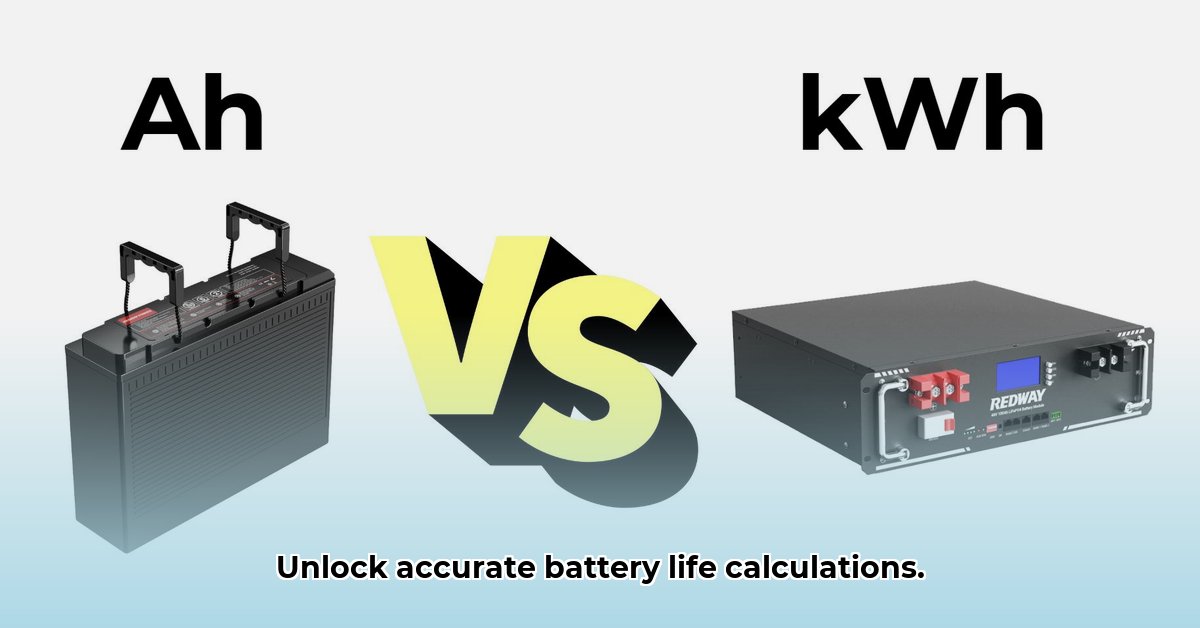Ever wondered how much power your battery truly holds? Understanding the relationship between amp-hours (Ah) and kilowatt-hours (kWh) is crucial for anyone working with batteries. This includes managing a solar power system, optimizing electric vehicle batteries, or ensuring your devices have the runtime you expect. This comprehensive guide provides a detailed breakdown of converting Ah to kWh, explaining the underlying principles, potential challenges, and advanced techniques for achieving accurate results.
Understanding Ah and kWh: A Practical Guide
Grasping the fundamental differences between amp-hours (Ah) and kilowatt-hours (kWh) is essential for effective battery management and accurately assessing energy needs. This guide offers a clear, concise explanation of the conversion process, highlighting common pitfalls and offering actionable advice for obtaining precise calculations.
Ah and kWh: The Basics Explained
Let’s clarify the definitions. Amp-hours (Ah) measure a battery’s capacity to store electrical charge, indicating the amount of current it can deliver over a specific duration. Think of it as the size of a fuel tank. Kilowatt-hours (kWh), on the other hand, represent the total energy a battery can supply. This is analogous to the total distance you can travel on a full tank of fuel. Understanding the distinction between nominal and usable capacity is critical for practical applications.
The Basic Conversion Formula
The fundamental formula for converting Ah to kWh is:
kWh = (Ah × V) / 1000
Where:
Ah= Amp-hours (battery capacity)V= Voltage (battery voltage)
This formula offers a quick estimate but assumes a constant voltage during discharge, which rarely occurs in real-world scenarios.
Real-World Factors: Efficiency, Temperature, and Peukert’s Law
The simple formula provides a theoretical value. However, battery voltage doesn’t remain constant during use. It typically decreases as the battery discharges. This voltage drop is influenced by battery chemistry (e.g., lead-acid, lithium-ion), battery age, temperature, and the discharge rate. Furthermore, Peukert’s Law dictates that a battery’s capacity decreases as the discharge rate increases. Consequently, usable kWh is typically less than the calculated value. Battery efficiency, which accounts for losses during charging and discharging, also plays a significant role.
Worked Example: Converting Ah to kWh Step-by-Step
Let’s illustrate the conversion with a common 12V, 100Ah car battery:
- Collect Data: Amp-hours (Ah) = 100, Voltage (V) = 12
- Apply the Formula: kWh = (100 Ah × 12 V) / 1000 = 1.2 kWh
- Interpret the Results: The theoretical energy is 1.2 kWh, but usable energy will likely be lower due to voltage drop, temperature, and discharge rate.
Connecting Batteries: Series vs. Parallel
The way you connect multiple batteries impacts the calculation:
- Series Connection: Voltages add up; Ah remains constant. Use the total voltage and a single battery’s Ah in the formula. This is used to increase the overall voltage of the system.
- Parallel Connection: Ah values add up; voltage remains constant. Use the total Ah and a single battery’s voltage in the formula. This is used to increase the overall capacity of the system.
Connecting batteries correctly is crucial for optimal performance and safety. Always consult with safety guidelines and consider professional installation.
Achieving Accurate Conversions: Advanced Techniques
For greater precision, consider these factors:
- Measure Average Voltage: Instead of relying on nominal voltage, measure the average voltage during discharge to account for voltage drop. Use a multimeter to take periodic voltage readings during a discharge cycle and average the results.
- Consult the Discharge Curve: Utilize the manufacturer-provided discharge curve for a more reliable estimation of usable energy. Discharge curves plot voltage against the percentage of discharge, providing a more accurate representation of battery behavior.
- Employ a Battery Management System (BMS): A BMS monitors battery state and provides accurate energy readings, including voltage, current, temperature, and state of charge.
- Account for Temperature: Use temperature compensation techniques to adjust for variations in battery performance due to temperature changes. Batteries perform best within a specific temperature range, and their capacity and voltage can be affected by extreme temperatures.
- Apply Peukert’s Law: Use Peukert’s Law to adjust the amp-hour capacity based on the discharge rate. This law acknowledges that a battery’s capacity decreases as the discharge rate increases.
Practical Considerations for Accurate Ah to kWh Calculations
| Factor | Impact on Accuracy | How to Improve Accuracy |
|---|---|---|
| Voltage Drop | Significantly reduces usable kWh by lowering the overall voltage available from the battery. | Measure average voltage during discharge, use discharge curve specific to your battery type, and consider using a battery with a flatter discharge curve. |
| Battery Age | Reduces capacity and increases voltage drop due to internal resistance and chemical changes within the battery. | Replace old batteries, monitor battery health regularly using a battery tester or BMS, and adjust calculations based on the battery’s state of health. |
| Temperature | Affects battery performance and voltage drop. High temperatures can temporarily increase capacity but can also accelerate degradation. Low temperatures reduce capacity and increase internal resistance. | Avoid extreme temperatures, operate within specified ranges recommended by the manufacturer, use temperature compensation techniques to adjust for temperature variations, and insulate batteries in cold environments. |
| Battery Chemistry | Different chemistries (e.g., lead-acid, lithium-ion) exhibit different discharge characteristics and voltage profiles. | Understand the specific characteristics of your battery type, use appropriate discharge curves and voltage correction factors, and consult manufacturer specifications for optimal performance parameters. |
| Discharge Rate | Higher discharge rates reduce usable capacity due to increased voltage drop and internal resistance. | Use Peukert’s Law to adjust for discharge rate, select batteries with higher C-ratings for high-current applications, and avoid discharging batteries at rates exceeding manufacturer specifications. |
| Internal Resistance | Causes energy loss as heat, reducing overall efficiency and usable kWh. | Choose batteries with low internal resistance, keep connections clean and tight to minimize resistance, and monitor temperature to prevent overheating. |
Key Insights for Successful Ah to kWh Conversions
- Accurate Ah to kWh conversion is vital for effectively managing energy storage systems.
- The formula kWh = (Ah × V) / 1000 requires precise voltage (V) measurement and awareness of voltage drop.
- Real-world factors, like voltage drop, battery configuration, temperature, and discharge rate, significantly affect accuracy.
- Understanding nominal versus usable capacity is essential for practical system design.
- Utilizing manufacturer specifications, discharge curves, and advanced techniques enhances conversion precision.
Ah to kWh Conversion for Electric Vehicle Battery Packs
Understanding electric vehicle (EV) batteries is complex, but being able to calculate the conversion between amp-hours and kilowatt-hours can make understanding battery range and capacity much easier.
Understanding Ah to kWh: Foundational Concepts
Amp-hours (Ah) quantify a battery’s capacity to deliver current over time, while kilowatt-hours (kWh) represent the total energy stored. Voltage (V) acts as the bridge between them. The formula is:
kWh = (Ah × V) / 1000
However, this is a simplified model. The accuracy is directly tied to how well this voltage reflects the conditions of the battery.
The Importance of Accurate Voltage Readings
The voltage value (V) is not constant. It fluctuates during discharge and charge cycles. Using the average voltage can improve accuracy, but integrating the voltage over the complete discharge curve provides the most precise estimate.
Step-by-Step Conversion: EV Battery Pack Example
Consider a 100Ah battery pack at 400V:
- Identify Ah and V: Ah = 100, V = 400.
- Apply the Formula: kWh = (100 Ah × 400 V) / 1000.
- Calculate kWh: Resulting in 40 kWh.
Factors Affecting the Accuracy of EV Battery Pack Calculations
Several factors influence the energy available:
- Battery State of Health (SOH): Degradation reduces energy output. SOH reflects the battery’s current condition compared to its original state.
- Temperature: Extreme temperatures impact battery performance. High temperatures can accelerate degradation, while low temperatures reduce capacity.
- Discharge Rate: High current draw reduces usable kWh. Peukert’s Law applies here, reducing effective capacity at higher discharge rates.
- Internal Resistance: Energy loss occurs as heat. Over time, internal resistance increases, further reducing efficiency.
- Charging Efficiency: Not all energy supplied during charging is stored. Charging
- Water Mill Electricity Generator Provides Free Home Power - December 16, 2025
- Water Wheel Electric Generator Provides Free Home Electricity - December 15, 2025
- Choosing the Right Portable Hydro Turbine for Your Needs - December 14, 2025
















